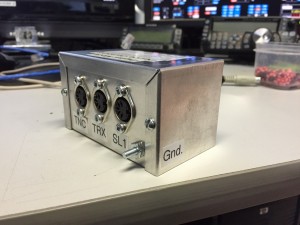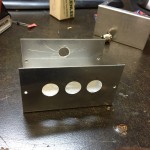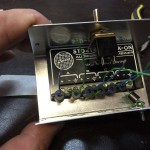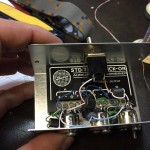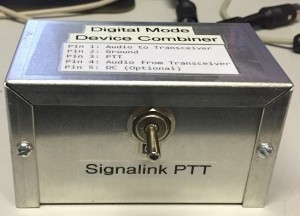 It’s funny how many little boxes and weird circuits end up on my desk whenever I start on a new project.
It’s funny how many little boxes and weird circuits end up on my desk whenever I start on a new project.
I built my dedicated ALE station a couple of weeks ago. The core components are a Kenwood TS-480HX and a Signalink SL-USB to send/receive audio from the transceiver. A couple of problems:
- Like almost every other rig out there, there is only one digital audio input on the TS-480. The Signalink is plugged into it, but I also have an SCS Pactor III TNC I want to use, but I don’t want to use a switchbox.
- MARS-ALE and PC-ALE require CAT or Serial-controlled PTT – VOX keying is too slow and must never be used. The Signalink is known for being an independent sound-card interface that uses VOX without the need for a serial-controlled PTT.
So, I want to combine the audio from 2 (or 3 or 4) sources into the data port, and be able to switch the PTT lead from the Signalink on and off if I want to. Ok, so I built it.
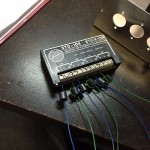 There already exists a passive audio combiner that is reasonably priced and readily available. I used the STD-10K for my application – It’s a 4 channel passive device that I’m using to combine the audio coming from my 2 sources into the transceiver (I have a spare channel should I want to add something else later). Yeah, yeah – I’m sure I could make the circuit myself, but little guy is already proven; a few members of CFARS are using this little guy for the same reasons I am.
There already exists a passive audio combiner that is reasonably priced and readily available. I used the STD-10K for my application – It’s a 4 channel passive device that I’m using to combine the audio coming from my 2 sources into the transceiver (I have a spare channel should I want to add something else later). Yeah, yeah – I’m sure I could make the circuit myself, but little guy is already proven; a few members of CFARS are using this little guy for the same reasons I am.
Other than that, the box and the connectors – I usually use 5-pin DIN for connectors when it’s my choice – I wanted to add a switch that I could use to pull the Signalink PTT line in and out as I please. I didn’t want to pull the PTT jumper from the Signalink because I may want to use another application (RTTY, PSK31, etc…) that I could use the VOX keying features with.
As you can see, I kind of went overboard with the ferrite inside the unit, but I’ve got sooo much RF floating around my shack, it’s pretty much a requirement to choke everything I possibly can. Now, I can have RMS Express running in the background in Pactor P2P mode and whenever someone establishes an ALE circuit with me, they can then establish a Pactor P2P connection with me and utilize the high transfer rate of Pactor to leave traffic with me. There are still a few bugs to work out here (i.e.: MARS-ALE needs to know when the PTT line is engaged by an external program to reset the timeout timer, but that’s for another day) but it works very well and neither device is causing interference with the other.
I’ve never liked using a switchbox to switch between different data devices feeding into a transceiver. Now I don’t have to, and neither do you 🙂
vy 73 de VA3QR!
